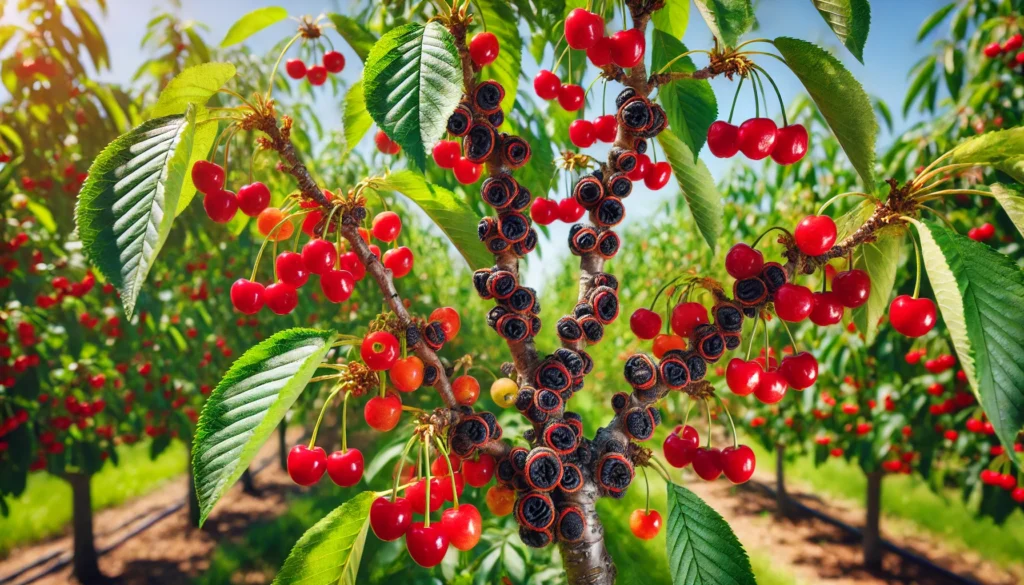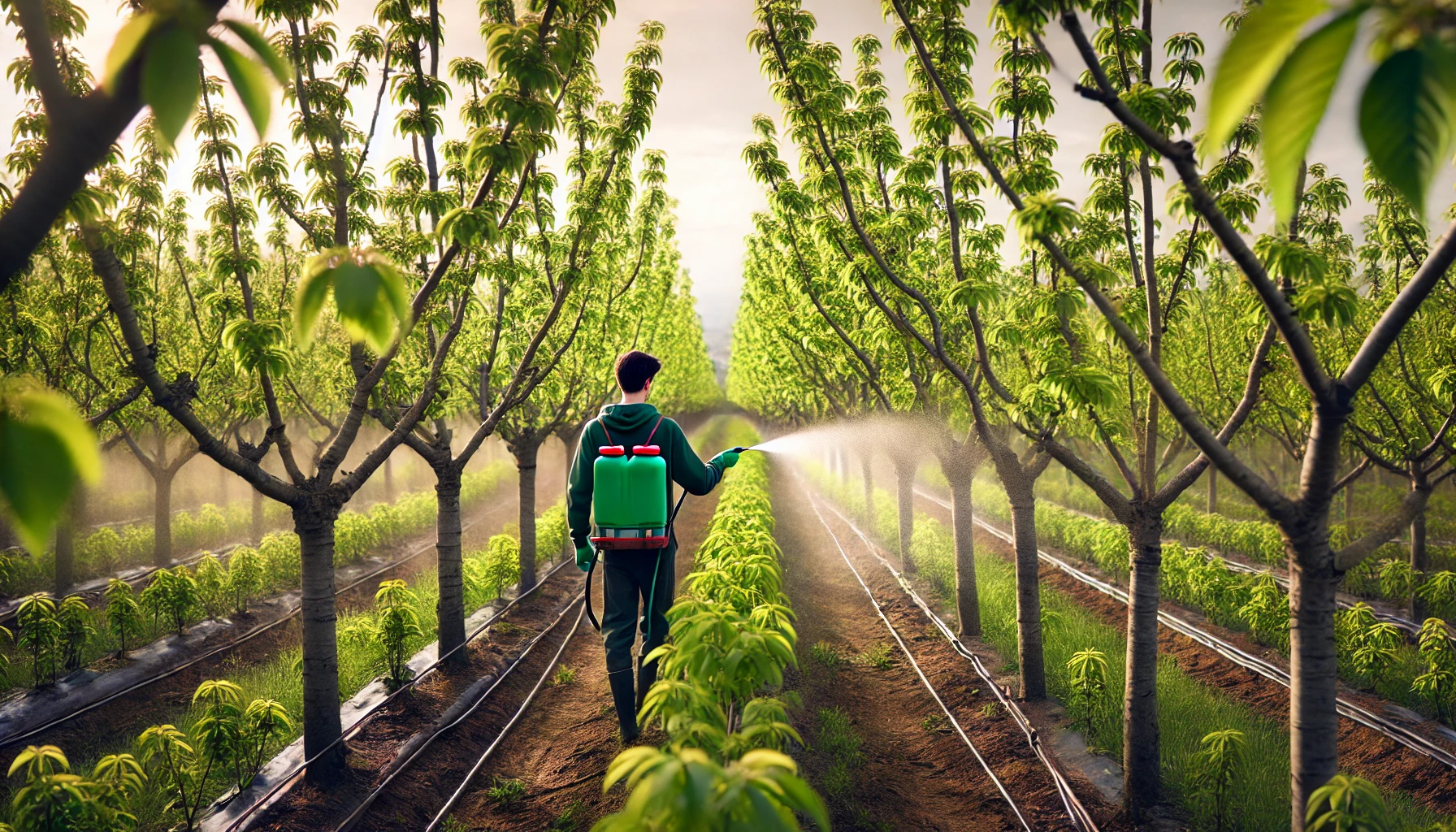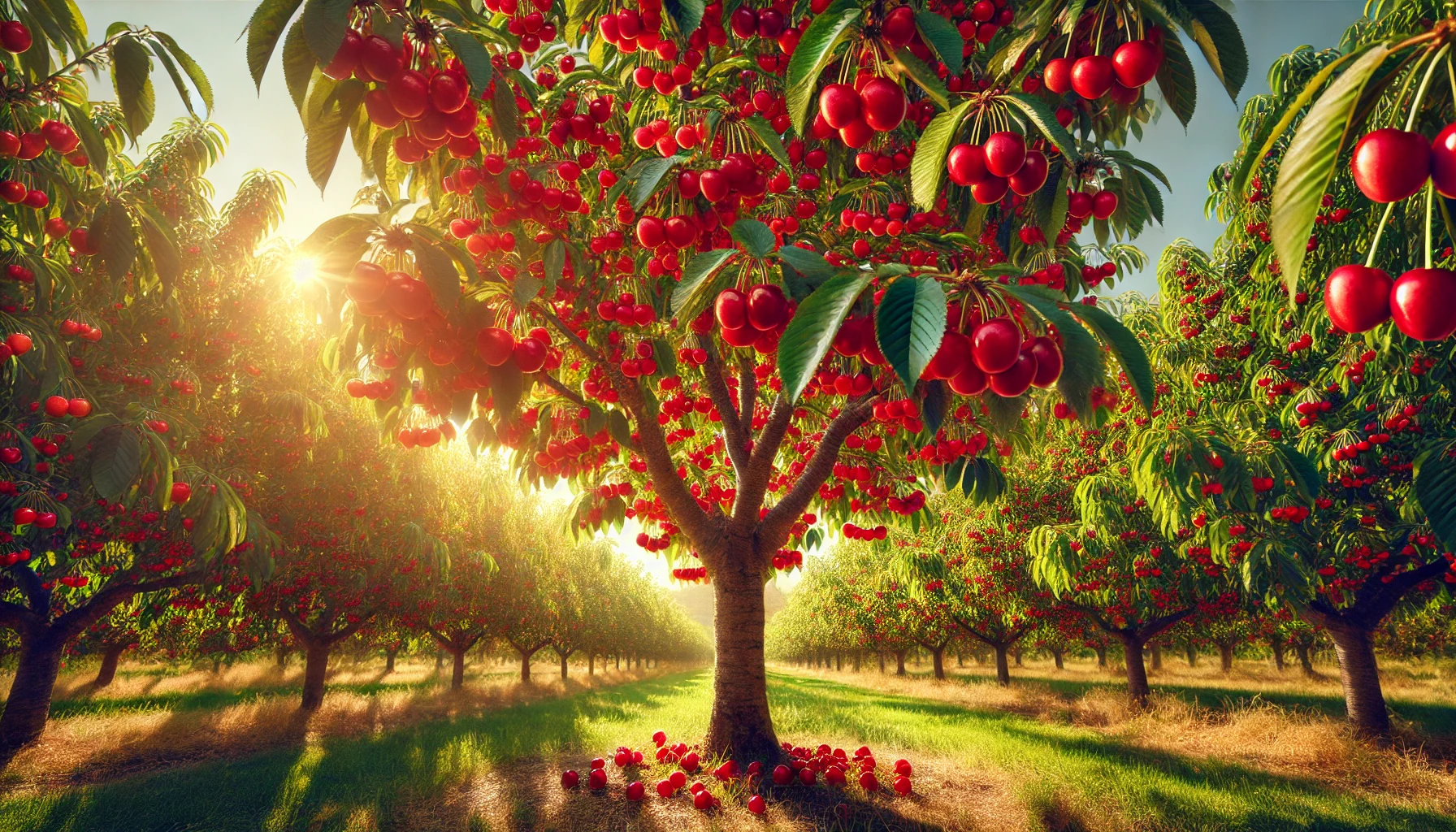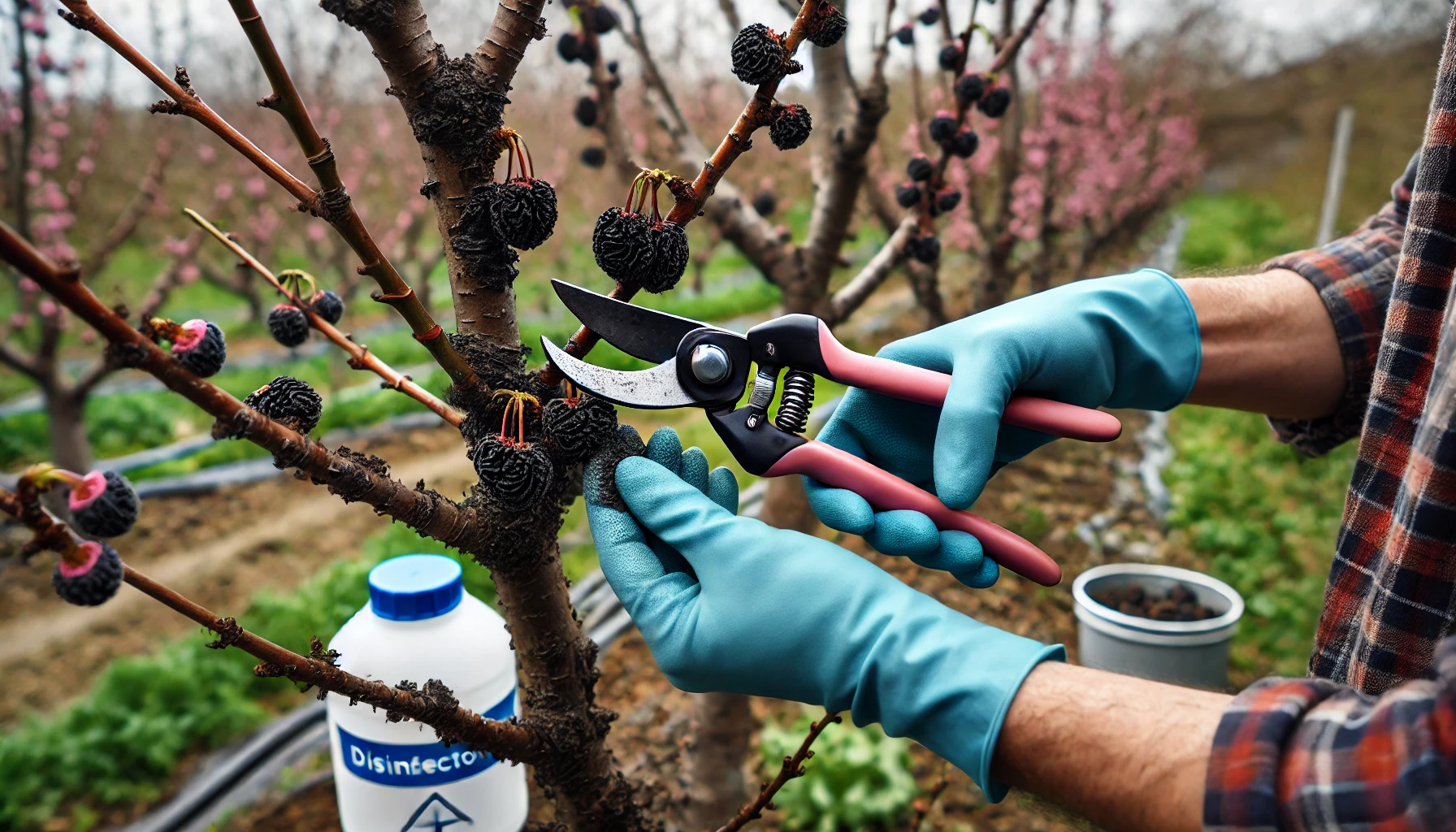
How to Identify and Treat Cherry Tree Black Knot Disease: A Complete Guide
Cherry trees are known for their beauty and delicious fruit, but they are also susceptible to a common and destructive disease: black knot. If left untreated, How to Identify and Treat Cherry Tree Black Knot Disease can cause significant damage, leading to stunted growth and even tree death. This fungal infection presents as black, swollen growths on branches, but catching it early is key to saving your tree. In this complete guide, we’ll show you how to spot the signs of black knot disease, understand its causes, and implement effective treatments to protect your cherry tree.
Table of Contents
ToggleWhat is Black Knot Disease? 
Black Knot Disease is a serious fungal infection that affects trees, particularly Prunus species like cherries, plums, and apricots. It’s caused by the fungus Apiosporina morbosa and is known for its distinctive black, swollen growths (or “knots”) on tree branches. These knots can grow large, making them easy to spot.
This disease weakens trees, restricting their ability to absorb nutrients and water, which can lead to poor growth or even death if left untreated.

Symptoms of Black Knot Disease include:
- Black, hard, swollen growths (knots) on branches
- Abnormal growths that are rough and lumpy
- Yellowing or wilting leaves as the tree’s health declines
It’s essential to catch Black Knot early, as it spreads quickly, especially in humid conditions. Timely action can prevent long-term damage to your trees. Stay tuned for how to identify, treat, and prevent Black Knot in the following sections!
How to Identify Cherry Tree Black Knot Disease 

Black Knot disease is a serious issue that affects cherry trees, causing twisted, dark, and swollen growths on the branches. Here’s how to spot it early:
Look for Black, Hard Nodules
The most noticeable symptom of Black Knot is the dark, knobby growths (also called galls) that appear on the tree’s branches. These galls are usually black and may have a rough texture. They often look like lumps or tumors.
Check for Swollen, Twisted Branches
As the galls grow, they cause the affected branches to swell and distort. This makes the branches appear twisted or deformed, preventing proper growth.

Early Signs in Spring
In early spring, before the leaves fully bloom, infected branches may show signs of dying back. The galls may start to soften and show signs of cracking, exposing black, spore-producing tissues.
Blackened Tips of Branches
In severe cases, the blackened galls spread into the branch tips, causing them to die off. This can result in reduced fruit production and overall tree health.
Look for Blackened Fruit
In the late summer or fall, you may notice that the fruit from infected branches looks stunted, blackened, or deformed.
Early identification and management are key to preventing Black Knot from spreading and killing your cherry tree. Keep an eye out for these signs to protect your trees!
The Life Cycle of Black Knot Disease
Black knot disease, caused by the fungus Apiosporina morbosa, follows a distinct life cycle that gardeners and tree owners should understand to effectively manage it. Here’s a clear breakdown of its stages:
- Infection Begins in Spring
The disease starts when the fungal spores (conidia) are released during wet spring weather. These spores are carried by rain or wind and infect new growth, especially on susceptible trees like cherries and plums.
- Formation of Black Knots
Once the spores land on the tree, they infect the branches, causing dark, swollen growths known as “black knots.” These knots are often visible by late spring and summer and can range from small to large, covering several inches in length. - Maturation of Knots
By fall, the knots mature, turning hard and black. Inside, the fungus produces sexual spores (ascospores), which will be dispersed in the next season, continuing the cycle. The knots restrict the flow of nutrients and water, weakening the tree over time. - Spore Release in Winter
During winter, the black knots continue to mature, releasing ascospores in the spring when conditions are wet. These spores will then start the infection process all over again, affecting healthy branches and spreading the disease.
Key Takeaway:
Preventing the spread of black knot disease is essential during its spore-producing seasons (spring and fall). Regularly prune infected branches and avoid using contaminated tools to stop the cycle from continuing.
By understanding the life cycle, you can act swiftly to manage black knot disease and protect your trees.
The Impact of Black Knot Disease on Your Cherry Tree 
Black Knot Disease is a serious fungal infection that can affect your cherry tree, leading to significant damage if not treated promptly. This disease is caused by the Apiosporina morbosa fungus, and it thrives in areas with high humidity and moderate temperatures. Understanding its impact is key to protecting your tree and ensuring its health.
Symptoms of Black Knot Disease
- Black, Hard Growths: Look for dark, swollen, and hard lumps on branches. These growths often appear in spring and can range from a few inches to several feet in length.
- Stunted Growth: Affected branches may stop growing, leading to a sparse canopy and reduced fruit yield.
- Dieback: If untreated, the disease can cause branches to die, severely weakening the tree.
How Black Knot Affects Cherry Trees
The fungus disrupts the tree’s vascular system, preventing the flow of nutrients and water. This leads to poor tree health, reduced vigor, and eventually, the death of branches or entire sections of the tree. Over time, untreated black knot can kill the tree.
Preventing Black Knot Disease
- Prune Infected Branches: Cut off and dispose of infected branches during the winter when the tree is dormant. Make sure to sterilize your pruning tools after each cut to prevent spreading the disease.
- Choose Resistant Varieties: Some cherry tree varieties are more resistant to black knot. Research and plant these varieties to minimize risk.
- Improve Air Circulation: Ensure proper spacing between trees and avoid overcrowding to reduce moisture buildup, which encourages fungal growth.
Treating Black Knot Disease
While there’s no cure, fungicides can help manage the disease. Apply them during the growing season, following label instructions. Early intervention is crucial to stop the fungus from spreading to other parts of the tree.
Protect your cherry tree from Black Knot Disease with vigilance and timely care. Regular inspections, proper pruning, and disease management are essential to keep your tree healthy and thriving!
How to Treat Cherry Tree Black Knot Disease 
Cherry tree black knot disease is a serious fungal infection that affects many types of cherry trees. If you notice black, swollen growths on branches or stems, this is a sign of the disease. Here’s how to effectively treat and manage it:
1. Prune Infected Areas 
- The first step is to remove the affected branches. Cut them back to healthy wood, ensuring the cuts are made at least 4-6 inches below the black knots. Dispose of the infected wood far away from the tree to prevent the disease from spreading.
2. Sterilize Pruning Tools 
- Always disinfect your pruning tools with rubbing alcohol or a bleach solution after each cut to avoid spreading the disease.
3. Apply Fungicide 
- Use a fungicide specifically designed for black knot disease. Apply it in early spring before buds swell and again after flowering. Be sure to follow the manufacturer’s instructions for application rates and timing.
4. Maintain Tree Health 
- Healthy trees are more resistant to disease. Water deeply during dry periods, and mulch around the base to retain moisture. Avoid over-fertilizing, as this can weaken the tree.
5. Remove Fallen Debris 
- Black knot spores overwinter in fallen leaves and branches. Clean up any debris around the tree to reduce the risk of reinfection.
By taking these simple yet effective steps, you can protect your cherry tree from black knot disease and help it thrive.
How to Prevent Black Knot Disease in Cherry Trees 
Black Knot Disease is a serious threat to cherry trees, but with the right precautions, you can prevent it from taking over your garden. Here’s how:
1. Choose Resistant Varieties 
Opt for cherry tree varieties that are resistant to Black Knot. Some cultivars, like Bing and Montmorency, are more susceptible, while others are bred for better resistance. Research before planting!
2. Prune Regularly 
Prune your cherry trees in late winter or early spring before new growth starts. Remove any infected branches, cutting well below the black knots. Always disinfect your pruning tools with rubbing alcohol to prevent spreading the disease.
3. Remove Infected Material 
Dispose of all infected branches and twigs immediately. Do not compost them, as this can spread the spores. Burning or bagging is the safest option.
4. Fungicide Applications 
Apply a fungicide specifically designed for Black Knot disease in early spring, just before bud break. Follow the manufacturer’s directions closely for effective protection.

5. Proper Tree Spacing 
Ensure your cherry trees are spaced properly to promote good air circulation. Dense planting can create a humid environment, which fosters the spread of fungal diseases like Black Knot.
6. Monitor Your Trees 
Regularly inspect your trees for any signs of Black Knot, especially during the growing season. Early detection is key to stopping it from spreading.
By following these simple steps, you can help your cherry trees stay healthy and free from Black Knot Disease. Stay proactive, and your cherry tree garden will thrive!
When to Seek Professional Help 
Sometimes, despite our best efforts, plant care can become overwhelming. Here are a few situations when it’s best to seek professional help:
- Severe Pest Infestation
If pests like aphids or mealybugs have taken over, and home remedies aren’t working, a professional pest control service can effectively tackle the issue. - Unidentified Plant Diseases
When your plant shows unusual symptoms like yellowing leaves, mold, or spots that you can’t identify, a plant expert can diagnose and recommend treatments.
- Persistent Yellowing or Wilting
If your plant is wilting or leaves are turning yellow despite proper care, it could be a sign of a deeper issue like root rot or improper watering. A professional can help assess and fix it. - Structural Issues with the Plant
If your plant’s structure seems weak or unstable, such as bending trunks or drooping branches, it may need expert pruning or support. - When You’re Uncertain About Repotting
Repotting can be tricky. If you’re unsure about the right time or technique, a plant specialist can guide you to prevent root shock or overcrowding.
Remember, seeking professional help ensures your plant gets the care it deserves and can thrive in the long run!
Bonus: Managing Black Knot Disease in Cherry Orchards 
Black Knot Disease is a common fungal infection that affects cherry trees, causing black, swollen growths on branches and twigs. If left untreated, it can seriously damage or even kill your trees. Here’s how to manage and prevent it:
1. Identify the Symptoms Early 
Look for dark, rough, and swollen galls on branches. These knots are often black or brown and are a clear sign of infection. Early detection helps in quick treatment.
2. Prune Infected Branches 
Remove any infected twigs or branches as soon as you spot them. Use sterilized tools to prevent spreading the fungus. Be sure to cut at least 6-8 inches below the affected area.
3. Dispose of Infected Plant Material 
Don’t leave the cut branches on the ground. Bag them and dispose of them away from the orchard to prevent further contamination.
4. Apply Fungicides 
Use a fungicide labeled for black knot disease, especially during the dormant season. Follow the manufacturer’s instructions for application timing, as timing is crucial for effectiveness.
5. Maintain Proper Tree Spacing 
Ensure good air circulation around your trees. Proper spacing can reduce humidity levels, making it harder for the fungus to spread.

6. Encourage Tree Health 
Healthy trees are more resistant to disease. Regularly water and fertilize your cherry trees, and keep an eye on their overall health to minimize the risk of infection.
By staying vigilant and taking these proactive steps, you can effectively manage black knot disease and keep your cherry orchard thriving.
 Conclusion
Conclusion
In conclusion, How to Identify and Treat Cherry Tree Black Knot Disease is crucial for maintaining the health of your cherry trees. Early detection and prompt action can prevent the disease from spreading and causing irreversible damage. By understanding the symptoms, treating the infection with proper pruning or fungicides, and adopting preventive measures, you can ensure that your cherry trees remain strong, vibrant, and productive.

Remember, regular care and inspection are key to catching black knot early. With the right approach, your cherry trees can thrive, producing beautiful blooms and delicious fruit for years to come. 
Frequently Asked Questions(FAQ)
What is Black Knot Disease on Cherry Trees?
Black knot disease is a fungal infection caused by Apiosporina morbosa that affects cherry trees. It creates black, swollen growths (knots) on branches, which can cause dieback and reduced fruit production if not treated.
How do I identify Black Knot Disease on my Cherry Tree?
Look for black, hard swellings on branches, especially in early spring or summer. These growths may initially appear as greenish, then turn black and become larger over time. Infected branches may also show signs of dieback.
What causes Black Knot Disease on Cherry Trees?
The disease is caused by the fungus Apiosporina morbosa, which spreads through airborne spores. These spores land on branches and infect them, particularly when the weather is moist and humid.
How can I treat Black Knot Disease on my Cherry Tree?
Pruning: Remove infected branches by cutting them 6-12 inches below the knot. Make sure to disinfect pruning tools between cuts. ✂️
Fungicides: Apply fungicides in early spring and throughout the growing season to control the spread of the disease. 🌿
Can Black Knot Disease kill my Cherry Tree?
Yes, if left untreated, black knot can lead to branch dieback, stunted growth, and even tree death. Early treatment is essential to prevent severe damage.
How can I prevent Black Knot Disease in Cherry Trees?
- Prune regularly to improve airflow and remove infected branches. ✂️
- Clean up fallen debris from around the tree to remove spores.
- Space trees properly to allow good air circulation and reduce humidity around the branches.
Inspect trees annually for early signs of infection. 🔍
Can I still eat fruit from a tree infected with Black Knot Disease?
While the fruit may still be safe to eat, it’s essential to treat the tree to prevent further damage to the tree and future fruit production. Affected fruit may be smaller or damaged, and the tree’s overall health may decline over time.
When is the best time to treat Black Knot Disease?
The best time to treat black knot is early spring, before the tree begins to bud. Continue treatment throughout the growing season, particularly after rainfall when fungal spores are most active. 🌧️










